Workplace safety begins with a trained workforce.
Only an effective employee training program can educate employees on the safety practices to be followed at a workplace. Employees should be trained in all job aspects, from menial to the riskiest activities they’ll be performing as a part of their duty.
Watch: What Is Employee Training
Irrespective of the size of an organization, health and safety should be the priority. Workplace safety training helps increase employee awareness, reduces workplace accidents and injuries, and protects organizations against legal penalties.
The statistics below will reinforce why you should conduct safety training for employees.
- There were around 3.2 million non-fatal workplace injuries in the US in 2020.
- More than 6,00,000 people died from hazardous substances in 2020.
- Slips and falls are the major causes of workplace injuries. In fact, 75% of occupational injuries are due to slips and falls.
- According to OSHA, safety training can save at least $4 to $6 for every $1 invested.
So, having a training program and raising awareness among your employees will help create a safe working culture. Organizations with a trained workforce have noticeably lower injury and fatality rates. That’s the reason why safety training is crucial for any organization.
In this blog, you’ll know more about safety training, its importance, topics to be covered in your program, and tips to create your training program.
What Is a Workplace Safety Program?
A workplace safety program is designed to educate employees on safety practices in the workplace. It aims at preventing injuries and accidents in the course of their duties that can negatively impact their productivity and threaten their lives.
The program includes specific guidelines or instructions on identifying, reporting, and managing hazards in the workplace. It also includes record-keeping for audit trails. Through such a training program, you can:
- Warn/alert your employees about a hazard on time
- Educate your employees on how to handle an unsafe and life-threatening situation
- Report the incident immediately to supervisors and other employees so they can take corrective measures and prevent recurring
Safety training in the workplace instills crucial skills, and enables employees to acquire knowledge of safety, which helps them identify and eradicate workplace hazards.
Safety brings first aid to the uninjured. – F.S. Hughes
Ensure the health, safety & well-being of your employees with safety training
Why Is Safety Training Important?
Safety training for employees is important because it reduces workplace injuries, boosts productivity, and creates a safer workplace.
Workplace safety training is critical to the following industries:
- Construction
- Manufacturing
- Healthcare
- Food/Hotel/Retail
These industries require regular safety and compliance training to prevent workplace injuries and perform tasks in a way that is safe for all the employees.
You can use a Learning Management System (LMS) for training your employees.

An LMS has all the features such as course authoring tools, virtual classrooms, AI reporting, assessments, surveys, etc., which makes it easy to create, deliver, and track training smoothly.
Now, let’s understand why you should impart safety training to your employees.
Increases Employee Awareness
Regardless of the industry, every workplace has its share of hazards.
For example, employees in the hospital industry can be exposed to risks such as slips and falls, chemicals and drugs, infected needles, burns, cuts, back injuries, etc.
Similarly, the common hazards at construction sites include equipment failure, hand-arm vibration, electrical hazards, slips and falls, and more.
Without proper training, these risks are often ignored and sometimes not even considered hazardous. Employee training programs will educate workers on identifying, addressing, and avoiding workplace hazards. It will increase their awareness of the hazards they might be exposed to!
Reduces Accidents, Injuries, and Fatalities
One of the main reasons safety training is important is that it helps employees become aware of workplace hazards and injuries, which reduces the number of accidents, injuries, and fatalities on job sites.
Employees who learn about safety procedures and practices are better prepared to avoid workplace risks and hazards. As a result, the number of accidents and workplace injuries decline.
Improves Productivity
Effective training programs bring down the number of accidents and injuries in workplaces. This means less sickness or absenteeism, which will inherently enhance workplace productivity. Plus, when employees are imparted with the knowledge of safety procedures, they can perform their duties unhampered.
On the contrary, the productivity level will decrease when workers who are unsure about the hazards and ways to eliminate them get affected by unsafe work conditions.
Ensures Ongoing Compliance
Workplace safety training is essential to comply with an organization’s safety policies as well as the rules and regulations of governing bodies.
When employees get injured at a workplace, the company becomes liable and accountable for such an injury. In fact, it puts a financial burden on companies as they have to pay compensation to injured workers as required by law.
Therefore, health and safety training protects organizations from compensational claims and lawsuits. This is also one of the reasons why more and more companies are providing safety training.
Strong Safety Culture
Workplace safety training programs lead to employees acting responsibly to ensure a safe working environment for everyone.
A safety culture connects everyone across all departments to place the highest importance on safety to reduce accidents and workplace injuries. Well-trained employees know how to respond to emergencies.
So, a safety culture can result in a happier workforce, typically leading to low absenteeism, high productivity, and more business stability.
That was all about the importance of safety training.
Now, you must be wondering which courses to include in your training program.
Don’t worry! We’ll share the ideas with you. Next, you’ll know about the various training topics you must include in your training program.
Watch: Preventing Musculoskeletal Disorders
Workplace Safety Training Topics
Safety training should be the top priority for every organization. However, every industry has specific training requirements, which often makes it challenging for organizations to decide on the right topics.
Workplace safety training has a lot of things to cover. For example, new hires need rigorous training on compliance and safety, while experienced employees need training to expand their knowledge base and stay updated with the latest job-related policies. Train your employees on different types of hazardous materials and how to prevent exposure to such materials. This will protect your workforce from physical injuries and health hazards.
Watch : How to Prevent Health Hazards in the Workplace | Training Course Introduction
However, there are a few training courses common to most industries. Organizations can keep their employees safe and uphold regulatory standards with such training.
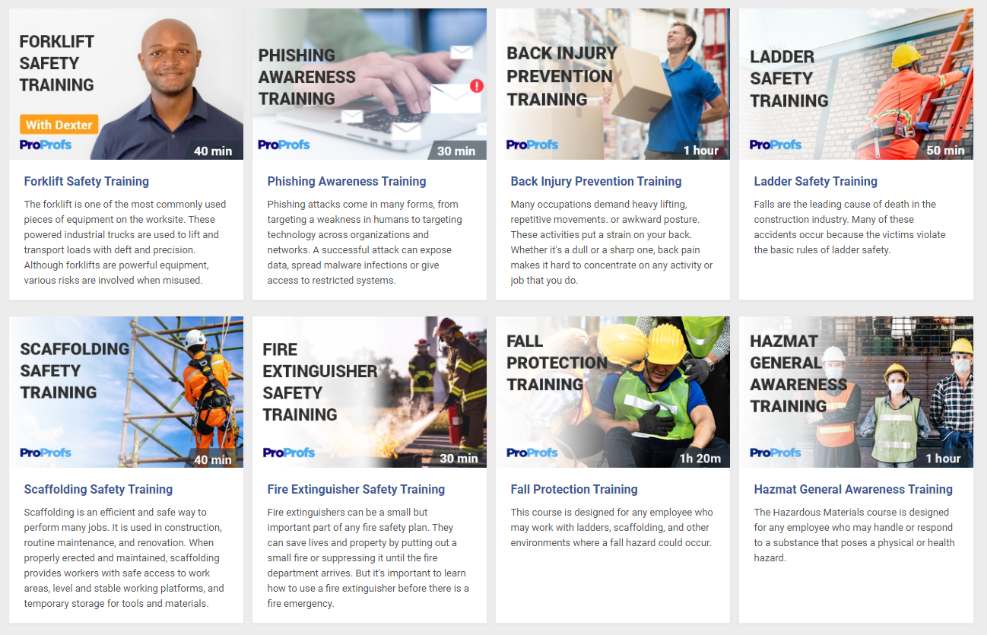
Here are some of them:
OSHA Training
OSHA safety training courses will educate your employees on occupational safety guidelines to be followed at their workplace.
Watch : What is OSHA Compliance Training
Companies who want to become OSHA compliant should implement an OSHA training program at the start of worker employment. That’s because new hires are at a higher risk of getting injured.
As per statistics, new workers are five times more likely to be injured than experienced staff. In fact, 40% of injuries are sustained by employees who are new on the job for less than one year.
The benefits of OSHA safety training include reduced workplace injuries and accidents, increased understanding of how to identify and prevent injuries, decreased worker’s compensation costs, and more.
Employees learn about the importance of injury and illness recordkeeping through OSHA training. Maintaining a record makes it easier to keep a track of such programs over a period of time.
COVID-19 Protocols
Coronavirus (COVID 19) is one of the trending topics and has led to a loss of millions of life and presented unprecedented challenges to the healthcare sector.
The crisis has impacted the work culture as well. From remote working to following strict Covid-19 protocols at workplaces, there has been a significant change in the way people work.
Your workplace safety training should include Covid-19 topics that would educate employees on the disease and ways to prevent it from spreading.

Below are some of the important things your Covid-19 training program should impart.
- Train your employees about the virus, its symptoms, how it spreads, and ways to reduce transmissions
- Information on how to isolate patients with covid symptoms or other infectious diseases
- Educate your employees on the measures taken by your organization to minimize the transmission risk.
- Right ways of using PPE kits and safely disposing of them
- Importance of wearing face masks all the time
- Social distancing guidelines
- Importance of washing hands and using sanitizers frequently
- Workspace disinfection and routine cleaning procedures
Besides this, train your employees on Covid-19 detection and reporting policies.
For instance, if an employee has runny nose and throat pain, whom to notify about it? What should the person do to minimize contamination until they leave the premises? All these things should be clearly informed through workplace safety training.
Personal Protective Equipment (PPE)
Employees should receive PPE training before being assigned tasks that require the use of PPE. It might sound over-exaggerated to say that training can save employees’ lives. But when it comes to PPE training, it’s true!
A PPE training is a training program that educates employees on the right ways of using PPE and disposing of them.
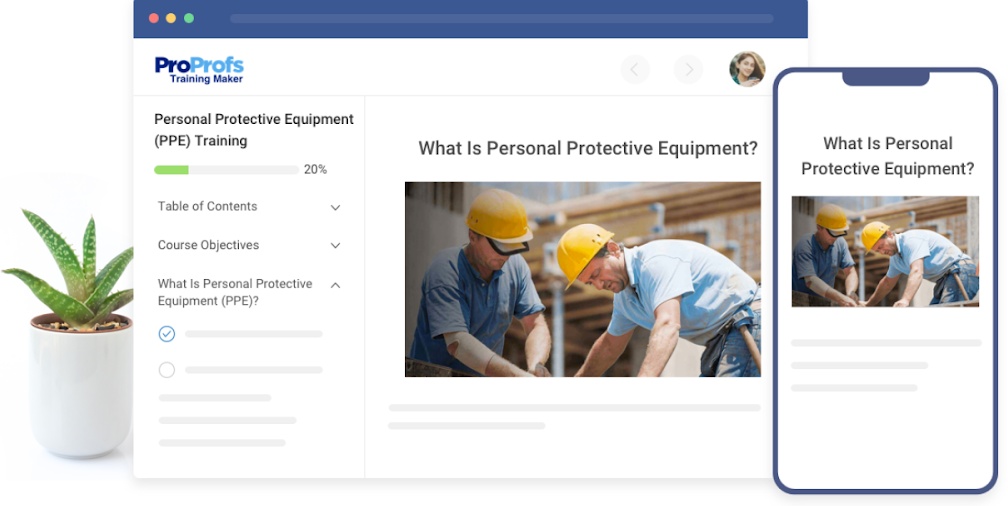
It lays down the guidelines and measures to keep employees safe from serious workplace illnesses and injuries that might result from contact with physical, chemical, radiological, mechanical, and other workplace hazards.
Your PPE training should include information on different types of PPE, such as head protection, clothing, footwear, hand, eye, and face protection. By providing this training, you’re keeping not just your employees safe but also those around them from accidental injuries and illnesses.
Watch: Personal Protective Equipment (PPE) Training Course
Bloodborne Pathogens (BBP)
Bloodborne Pathogens (BBP) are pathogenic microorganisms present in human blood, such as Hepatitis B (HBV), Hepatitis C (HPC), and Human Immunodeficiency Virus (HIV). Other infectious materials include amniotic fluid, organ cultures, semen, saliva during dental procedures, and more.
BBP training is mainly designed for those who may come into contact with infected human blood and other potentially infectious materials. This training is mainly for waste pickers, medical workers, and housekeeping staff.
Watch: What Is a Bloodborne Pathogen Training? | Course Introduction
BBP training courses educate employees on how these pathogens are spread, ways to avoid exposure, and measures to take if exposed to such harmful materials.
Sexual Harassment
You’re not a victim for sharing your story. You are a survivor setting the world on fire with your truth. And you never know who needs your light, your warmth, and raging courage. – Alex Elle
Did you know that the largest number of sexual harassment cases come from the healthcare, hospitality and restaurant industry?
Therefore, such industries need rigorous training on sexual harassment to create a respectful and safe environment where all employees feel safe, confident, and enjoy working.
Watch: What Is Sexual Harassment Prevention in Healthcare
Though the ‘Me Too’ movement inspired many men and women to speak up about their traumas in front of the world, sexual harassment is still a major workplace problem. Sexual harassment at a workplace is of two types – hostile work environment and quid pro quo.
Quid pro quo is sexual harassment where supervisors/managers may ask for sexual favors in exchange for a salary hike, promotion, job acceptance, etc. A hostile work environment, on the other hand, includes all situations that cause someone to feel uncomfortable and emotionally distressed. For example, sexual violence, comment of sexual nature, inappropriate touching, etc.
Your employees should be aware of all these types of sexual harassment taking place in many organizations and have the knowledge to take appropriate actions if they are harassed. Sexual harassment is a kind of compliance training that educates employees on acceptable and unacceptable behavior.
It trains employees on the types of conduct that constitute sexual harassment. Train your employees to protect their wellbeing and safeguard your organization against legal actions and compensations.
Slips and Falls
Slips and falls are one of the main causes of workplace injuries and fatalities.

Falls are the most common cause of hip fractures and brain injury. Such injuries can lead to deaths as well. Therefore, employees should be thoroughly trained on workplace hazards and ways to avoid them. Help them understand the various causes of slips and falls and how to prevent them.
Watch: How to Protect Workers From Fall Hazards | Training Course Introduction
Slips and falls may happen due to any of the following reasons:
- Occasional spills
- Wet/oily surfaces
- Wet/uneven surfaces
- Poor housekeeping
- Trailing cables
- Poor lighting
- Unsafe ladders and stairs
Every year, a large number of workers suffer injuries or die due to falls from heights.
Wrong use of ladders and failure to follow the ladder safety guidelines are the leading causes of falls.
Workplace safety courses such as ladder safety training should be conducted to train employees on risk identification, recognizing signs of wear, using proper footwear and equipment, and more.
Watch: Ladder Safety Training
Protecting workers against slips and falls is one of the primary responsibilities of employers. They are responsible for maintaining worksites, investing in good quality housekeeping products, conducting workplace safety training, and developing a safety culture.
Fire Safety Training
Fire is one of the most common hazards in the workplace that can cause property loss, multiple fatalities, legal claims, compensations, and fines.
Organizations should have fire extinguishers and other fire prevention mechanisms to avoid the serious consequences of a fire outbreak.
Employers should take the responsibility to create awareness among employees through a proper training program. A fire safety training program is important for all industries, such as healthcare facilities, retail spaces, restaurants, office properties, industrial warehouses, and more.
Fire safety training is designed to educate workers on the set of practices and procedures to avoid the destruction caused by fire. This training should include:
- Information on the types and causes of fire
- Information on handling fire disasters
- Fire prevention techniques
- Knowledge of how and when to use fire extinguishers
- Fire emergency plans
- Information on evacuation procedures
Watch: Fire Extinguisher Safety Training
From CEOs to clerks, everyone should receive fire safety training. Nearly 11 deaths are reported every day due to fire. Most US workplaces are required to provide fire safety training because OSHA requires employees to receive training to help them identify signs of fire hazards and evacuate safely.
Now that you have a clear idea of the safety training topics for employees, your next step is to create an effective training program. Let’s see how you can do that.
10 Steps to Create Workplace Safety Training Programs
The OSHA Act provides detailed guidelines on employee health and safety standards.
Organizations must comply with the OSHA standards and guidelines to create a safe and healthy working environment. Companies should design an effective safety training program to adhere to the laws and guidelines.
Below are the steps you can follow to create an effective safety training program.
Step 1: Identify Your Workplace Hazards
The first thing you need to do is identify your workplace hazards. Your safety training cannot be effective unless you know what you’re trying to protect your employees from.
You can perform a Job Hazard Analysis (JHA) for hazard identification. It is a technique for evaluating hazards associated with specific jobs and mitigating them to prevent injuries.
The process involves:
- Selecting the activity/job to be analyzed
- Breaking the job into small steps
- Identifying potential risks and hazards in each task involved
- Finding preventive measures to overcome these risks
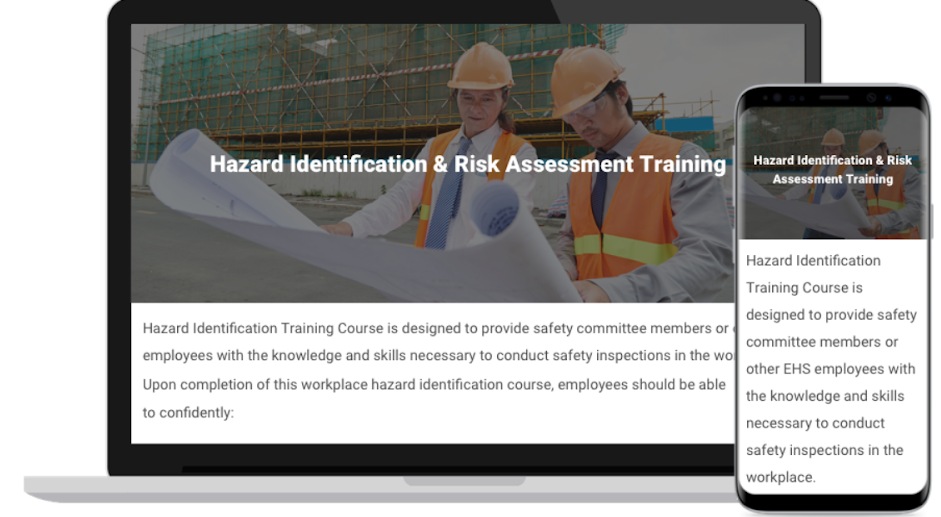
Step 2: Know the Safety Training Regulations
Knowing the safety training requirements that regulatory agencies like OSHA put on your workplace is extremely important and helpful.
Meeting the safety compliances laid down by these regulatory bodies builds a safe workplace culture and protects your organization from lawsuits and compensations.
Step 3: Analyze Training Needs
To create an effective training program, it’s essential to determine employee training needs. This can be done by checking the latest organization’s health and safety records. Find out the latest incidents and hazards and check if all the employees are aware of them.
You can also take pre-training assessments to identify knowledge gaps. This will help identify what you should incorporate into your training program.

Step 4: Set Training Objectives
The training objectives are measurable outcomes that you want your employees to achieve after the training. The objective can relate to acquiring new skills or behavior, learning new procedures, and creating awareness.
Training experience should be in tandem with the objectives and goals to make the training program effective and functional. Make sure you set realistic objectives that are clear and measurable.
Watch: How to Set SMART Goals
Choosing the right workplace safety training courses is important to ensure that you deliver the right knowledge to your employees that are relevant to their jobs and activities. Every industry has risks and hazards specific to its workplace. Therefore, selecting the right course is important.
With an LMS, you can access readymade courses and training templates for instant use. You can also create courses from scratch using existing documents, videos, presentations, and PDFs.
Watch: How to Create an Online Course
Step 6: Create Engaging Content
The best way to create an effective training program is to make it engaging and interesting. You can add elements such as images, videos, PDFs, and multimedia to keep your learners engaged.
Add brain games, learning paths, flash cards, and quizzes with an option for video responses to your content to encourage healthy competition among learners.

Engaging content goes a long way in enhancing learners’ interest, knowledge retention, and preventing dropouts.
Watch: How to Investigate a Workplace Accident | Training Course Introduction
Step 7: Decide on the Right Training Tool
Workplace safety training can be effective when delivered correctly. For this, you need to decide on the right training tool to help learners access the training materials 24/7 at their convenience.
Online training software helps in delivering training in an optimized way. It has all the features such as virtual classrooms, collaboration tools, learning paths, course library, readymade training templates, LMS reports, etc.

There are plenty of other ways by which you can deliver training, such as webinars, live streaming, group sessions, blended learning, and more. You can choose the most suitable tool based on your business requirements and learners’ preference.
Automate Safety & Compliance Training With Safety Training Software
Step 8: Implement the Training Program
Now that you’re ready with the course materials, you need to schedule and conduct your training. Before rolling out your program, make sure you test the validity and effectiveness of your course with a sample audience.
One of the main benefits of pilot testing is that it warns you about where your training program could fail. By identifying these things beforehand, you can ensure that the learning objectives are met.
If the outcome of the test is satisfactory, you can go ahead and distribute your training course to the rest of your learners.
Step 9: Add Assessments and Quizzes
Tracking learner progress is important to know how well your employees have performed. You can add assessments and quizzes into your course to assess knowledge retention.
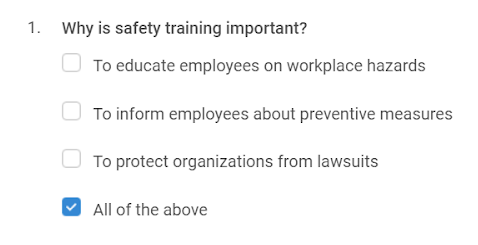
Evaluation is important because it helps determine if the learning objectives are met. With some LMS systems, you get 1,00,000+ quiz templates, a library of professionally designed tests, delightful reports, software integrations, etc. In fact, it also lets participants respond to questions by recording videos.
Step 10: Collect Feedback and Revise Your Training
Collecting feedback from learners is important for the success of your workplace safety training program.
Your learners should be able to achieve all learning objectives and be allowed to share their feedback on your training program. It’s difficult to evaluate the effectiveness of your program without collecting feedback.
Add online surveys at any point in your course to collect actionable feedback on course content, instructors, and delivery methods.
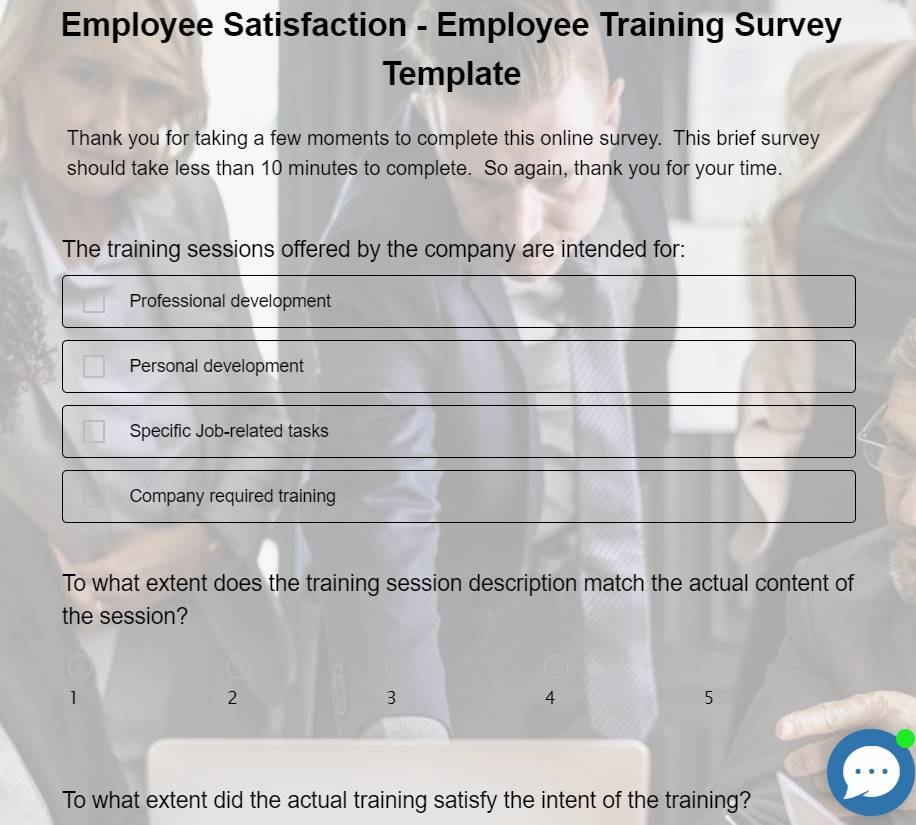
The results you obtain from the surveys will help you make necessary improvements in your course. This will altogether enhance your training program and also the overall learning experience.
Watch: Assessing Employee Satisfaction with Surveys
These were some of the essential steps that’ll help in creating a meaningful and effective training program.
Get Free Employee Training Software — All Features, Forever.
We've helped 567 companies train 200,000+ employees. Create courses in under a minute with our AI LMS or use 200+ ready-made courses on compliance, harassment, DEI, onboarding, and more!
Start Creating Your Workplace Safety Training Program
To sum up, workplace safety training is important to prevent workplace injuries, increase employee awareness, and build a safe and strong safety culture.
Before creating your program, identify workplace hazards, set learning objectives, and create engaging content for learners. Test their knowledge and collect actionable feedback from them to improve your course quality.
To do this, you can use an LMS as it has all the resources such as course creation tools, mobile learning, collaboration opportunities, virtual classrooms, reports, assessments, surveys, certificates, and more.
So, what are you waiting for? Train your employees, create a safe work culture, and enhance workplace productivity.


 We'd love your feedback!
We'd love your feedback! Thanks for your feedback!
Thanks for your feedback!






![10 Best Compliance Training Software for 2025 [Updated List]](https://www.proprofstraining.com/blog/wp-content/uploads/2023/03/X_Best_Compliance_Training_Software_in_2023.png)

